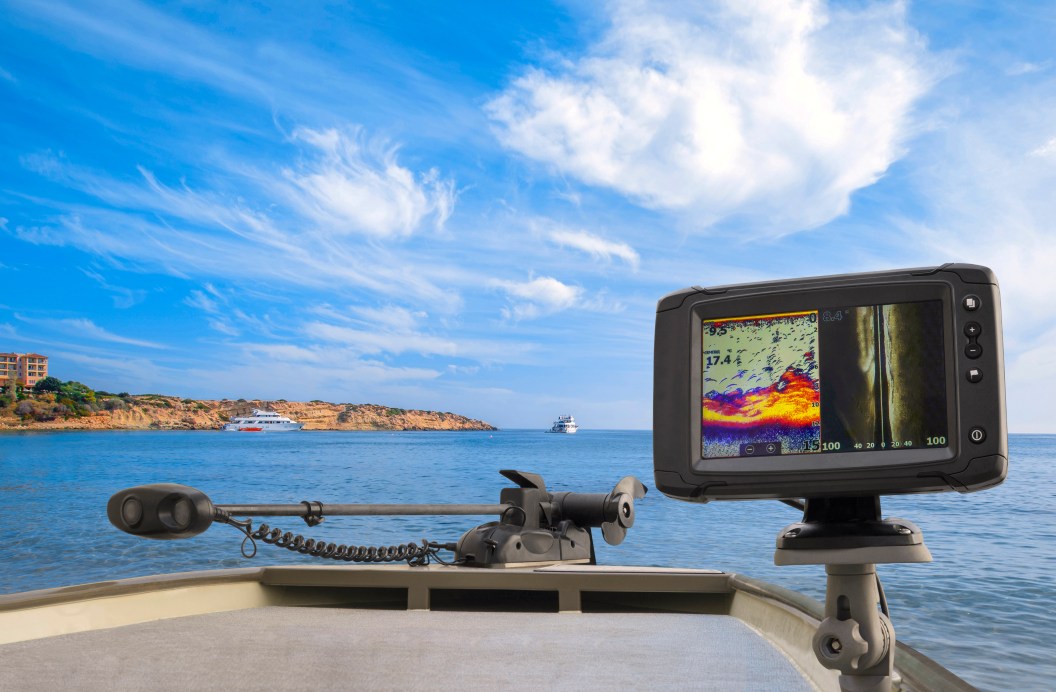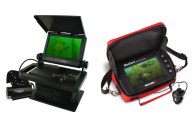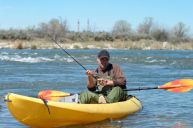Anglers have always wished for X-ray vision to see underwater. As an angler for over 30 years myself, I've been around long enough to remember when we used to call a fish finder a "fish graph" because the early devices used graph paper for the readout.
The invention of liquid crystal recorders (LCR) started a revolution in fish finders. And these underwater scanners only continued to improve, thanks to the additions of live sonar imaging, side sonar technology, and 360-degree imaging. Now, the waters around our boats have never been more transparent, with some fishing forums even calling for fish finders to be banned on the pro bass circuits.
But for recreational anglers, this simply means that we can make our shorter fishing trips a lot more successful—and gives us a big reminder of why the catch-and-release mantra is so important.
I've owned multiple boats and fish finders in my life, and I've been using this technology for a better fishing experience almost from the beginning. The best fish finders are the ones that are easy to learn and use, have a clear screen, and offer good value for their price.
The Best Fish Finders of 2023
- Best Fish Finder Overall: Garmin Striker Vivid
- Best Budget Fish Finder: Garmin Striker 4
- Best Kayak Fish Finder: Hawkeye FishTrax PaddleSport
- Best Ice Fishing Fish Finder: Humminbird Ice Helix 7
- Best Side-Imaging Fish Finder: Lowrance Elite FS 7
- Best Fish Finder Splurge: Humminbird Solix 10
Best Fish Finder Overall
Top Pick: Garmin Striker Vivid ($300)
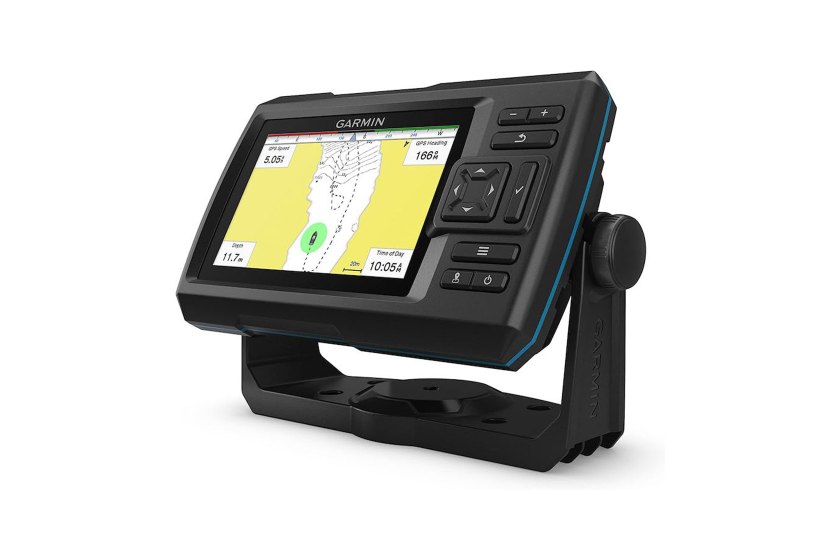
Courtesy of Garmin
Screen size: 5 inches | Resolution: 800 x 480 pixels | Includes transducer: Yes | Max depth: 800 feet | Sensor types: Temperature and speed | Pre-loaded maps: Optional for additional fee | Power source: 12-volt DC | Mounting hardware: Tilt/swivel mount included
The Striker Vivid is easy to learn and use, with enough features to all but guarantee a catch, whether you're just starting out or are a seasoned angler. It comes in four display sizes, from 4 inches to 9 inches, but we think most anglers will be satisfied with the 5-inch screen. It might not be the largest one offered, but it's plenty big enough to see from all angles; and with the crystal-clear resolution, you can read the map info with ease, even while moving.
Regardless of the screen size you choose, you have the option to change the sonar readout colors or perform a three-way screen split to view multiple displays at once. This is helpful for entry-level users because it gives the option to customize to a favored hue to more quickly identify fish.
Unless you pay extra, it doesn't include pre-loaded bathymetric maps (e.g., underwater topographic images for many popular waterways). But even without, its vaunted Quickdraw system will use GPS to create maps for you as you go, so you'll have them each time you return to the same waters. Also not included: a mount for the transducer, though you can pick one up for $20 more.
- Plenty of display size options to please any angler
- Excellent depth of clarity
- No transducer mount included
- Not preloaded with maps
Best Budget Fish Finder
Top Pick: Garmin Striker 4 ($?140)
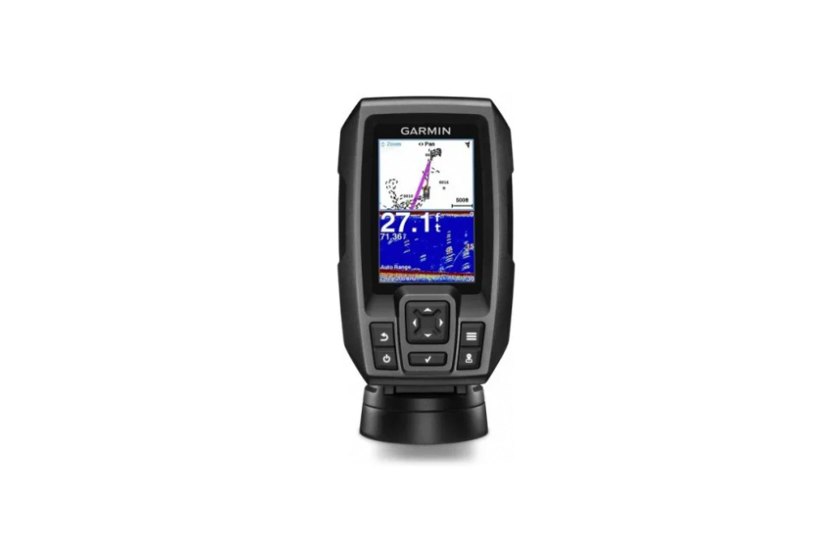
Courtesy of Garmin
Screen size: 3.5 inches | Resolution: 480 x 320 pixels | Includes transducer: Yes | Max depth: 1,600 feet | Sensor types: Temperature and speed | Pre-loaded maps: Yes | Power source: Rechargeable battery | Mounting hardware: Tilt/swivel mount included
Don't assume that a smaller screen and resolution automatically mean a less-functional unit. The Striker 4 may be small, but you'll be impressed by the tech included in this inexpensive fish finder. If a lower price is your highest criteria, you'll see the value in this one, even though the small screen isn't for everyone.
With the included transducer, this is a great buy, and any angler—novice or seasoned—can easily mount it and begin to use it right away. The user-friendly keypad system is great for navigating the maps and different screens quickly and easily, or you can pay more for a touchscreen-enabled version. It also boasts an impressive depth of 1,600 feet in freshwater. Just be sure you charge it up before you head out, as it runs on a battery.
- Excellent price
- Screen is easy to see even in sunlight
- 3.5-inch screen; smallest on this list
Best Kayak Fish Finder
Top Pick: Hawkeye FishTrax PaddleSport ($200)
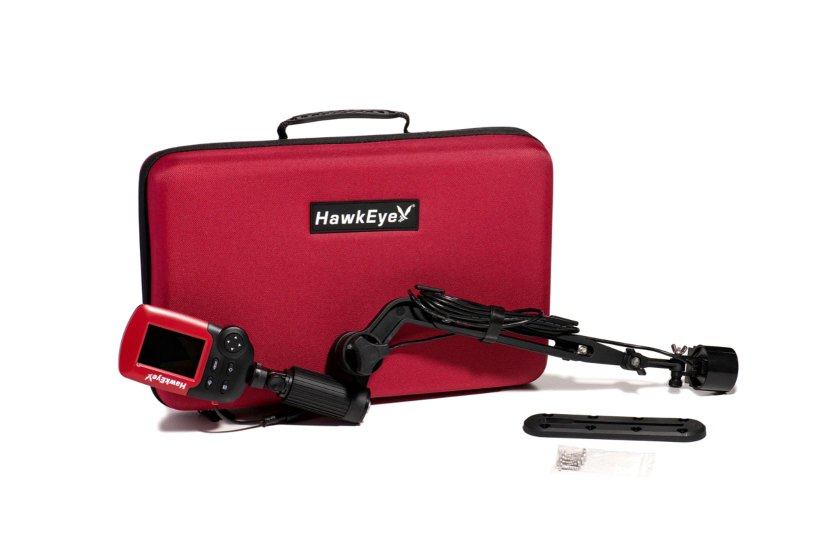
Courtest of Hawkeye
Screen size: 4 inches | Resolution: Not available | Includes transducer: Yes | Max depth: 240 feet | Sensor type: Water temperature only | Pre-loaded maps: No | Power source: Four AAA batteries | Mounting hardware: Portable post mount included
This is a simple tool for a simple pleasure: paddling in your favorite kayak and finding all the fish you've been missing. The Hawkeye FishTrax has a "high definition" color display (no resolution specs given) that renders your possible targets below as small digital "fish." It runs on four AAA batteries, so it's easy enough to pack extra just in case it runs out of juice mid-trip. The included storage case makes it a breeze to travel with and put away if you just want to paddle.
The unit can move around on the mount as you travel and can get in the way if you place it on the kayak too close to your paddling zone, but that's just a matter of planning ahead. The kayak installation is simple, and the operation won't take you long to figure out.
- Fully portable
- Easy setup
- All-in-one mounting kit
- Screen display is smaller than most
Best Ice Fishing Fish Finder
Top Pick: Humminbird Ice Helix 7 ($1,050)
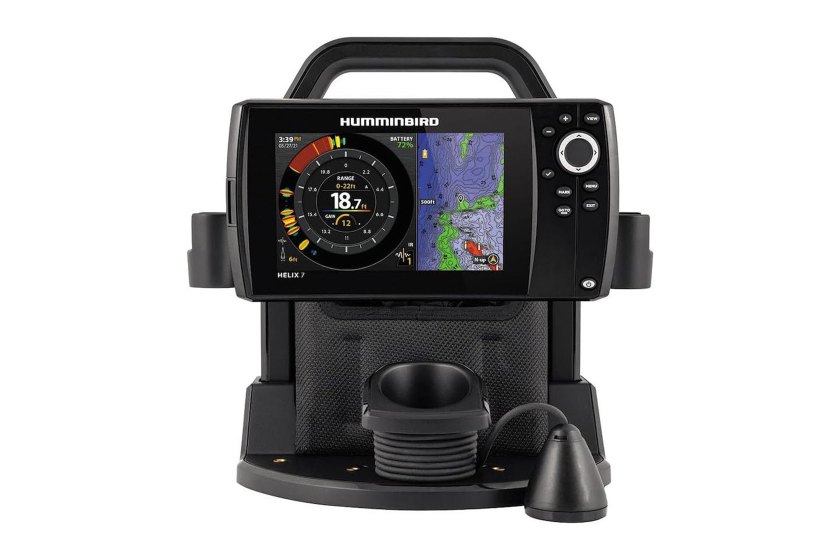
Courtesy of Humminbird
Screen size: 7 inches | Resolution: 1024 x 600 pixels | Includes transducer: Yes | Max depth: 400 feet | Sensor type: Temperature | Pre-loaded maps: Yes | Power source: Rechargeable 15Ah lithium battery | Mounting hardware: N/A
If you're going to spend any time out on the ice during the coldest part of the year, then you need to have a unit that can pinpoint your location by marking the waypoints where you have been traveling—including to your most productive areas—and navigate out to your spot and back safely with GPS.
Included are charts and maps of over 10,000 bodies of water to keep you ahead of the rest of the ice-fishing crowd. Included components are a charger, power cables, and both a transom mount and a suction-cup mount for the transducer.
Normally, the weight of a fish finder doesn't matter because, generally, these electronic components don't take up much space. But for ice fishing, you're hauling everything out yourself; and with the entire Ice Helix 7 coming in at 15 pounds, it will make the load on your sled even heavier.
Another caveat: You have to make sure that you have a full charge—which lasts about 15 hours—for a day out on the ice (especially since cold temps drain battery life faster).
- All-season fish finder
- Saves screenshots to keep sonar recordings and waypoints
- 7-inch screen size is a little small for the open ice
Best Side-Imaging Fish Finder
Top Pick: Lowrance Elite FS 7 ($899)
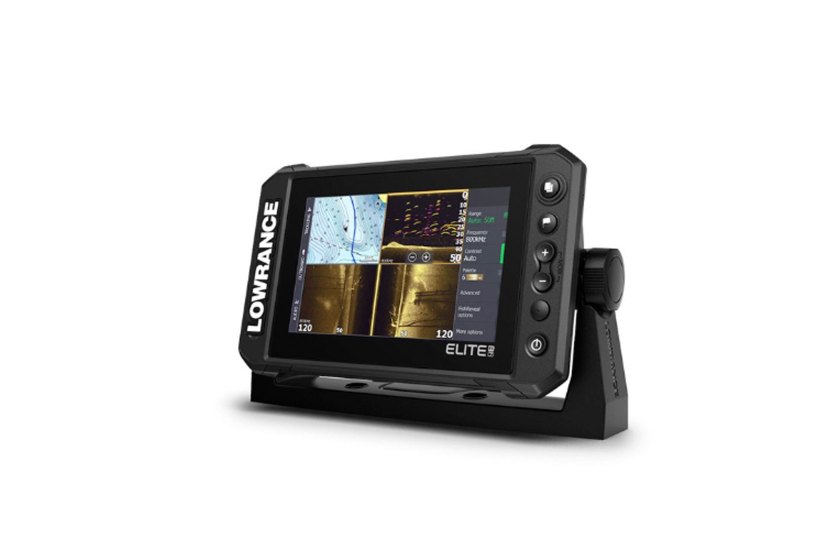
Courtesy of Lowrance
Screen size: 7 inches | Resolution: 800 x 480 pixels | Includes transducer: Yes | Max depth: 1,000 feet | Sensor type: Temperature built-in; speed optional | Pre-loaded maps: Yes | Power source: 12-volt DC | Mounting hardware: Gimbal bracket, which allows for up-and-down movement
For those of us who got tired of wondering what was "over there" as opposed to just underneath the boat, side-imaging technology changed the fishing game for good. The Elite FS 7 is our pick for the serious angler who wants a sonar with both down- and side-imaging capability. It has stood the test of time and can be upgraded for multiple uses.
If you haven't heard of Lowrance's vaunted ActiveTarget imaging, it's basically like having an underwater camera to let you know exactly how the fish are moving and the structure that they're relating to at the very moment that you're observing them.
While this unit is higher priced than many, if you want to play with the big boys, then you're going to have to pay a little more. And it's a great value for your money, as a trolling motor-compatible transducer and all those North American maps are included.
- Equipped with both U.S. and Canadian lake maps
- Ice fishing-compatible with the Lowrance Portable Power Pack
- Doesn't include an in-dash mount, if your boat has a dashboard and you were hoping to mount it there
Best Fish Finder Splurge
Top Pick: Humminbird Solix 10 ($2,400)
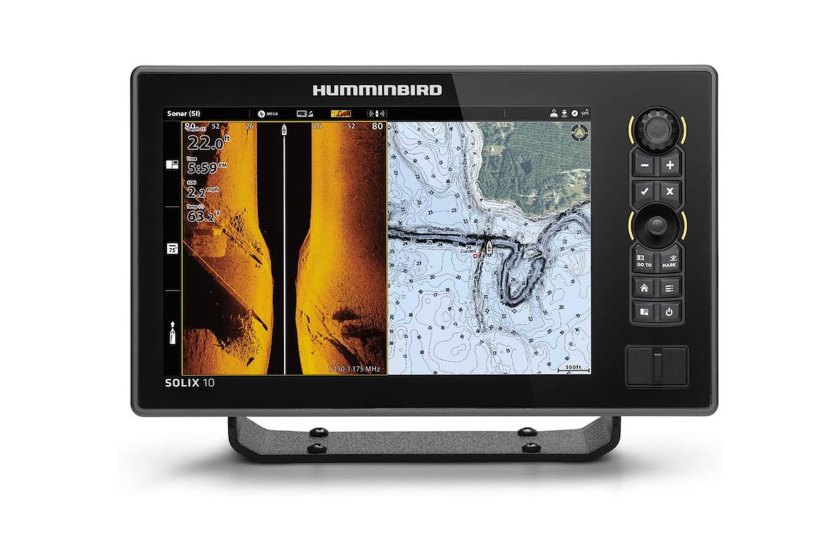
Screen size: 10.1 inches | Resolution: 1280 x 800 pixels | Includes transducer: No | Max depth: 1,200 feet; side imaging: 250 feet | Sensor type: Temperature and speed | Pre-loaded maps: Yes | Power source: 12-volt DC | Mounting hardware: Gimbal bracket
If money is no object and the ultimate in underwater detection is your aim, we must recommend the Solix 10. With it, you can view down and sideways to impressive depths (1,200 feet and 250 feet, respectively) and see it all from anywhere on the boat on a large, 1280 x 800 resolution display. It has all the makings of a sonar that you will never replace.
Sure, the Humminbird Solix 10 is expensive, but not when you consider all that you get: a 10-inch backlit HD touchscreen, Bluetooth capability, plus the ability to split the screen so you can have a chart, down imaging, a sonar graph, and side imaging all displayed at once.
Humminbird doesn't include a transducer with this unit, opting to offer serious anglers the ability to choose their own. The options include two transom-mount transducers (one for down imaging and side imaging) and one in-hull transducer that can see right through the bottom of the boat.
As always, Humminbird includes base maps for some 10,000 U.S. lakes and inland waterways, but unfortunately not any for Canadian waters.
- Excellent 1,200 depth range
- Loaded with customizable features
- Fits on any boat
- Expensive and doesn't include a transducer
What to Look For When Buying a Fish Finder
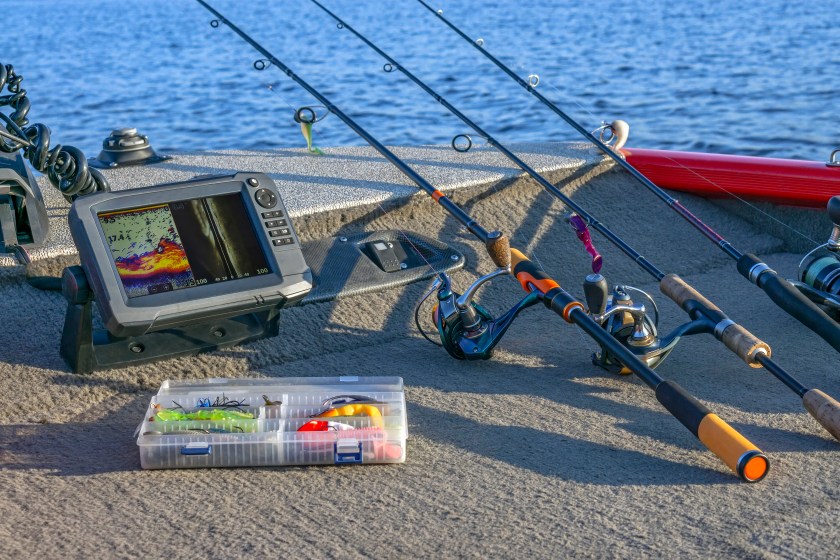
Getty Images, FedBul
A good quality fish finder can make the difference between a great day on the water and a frustrating one when you unknowingly cast a line in an area that's devoid of anything worth catching.
Technically, you can put any fish finder you want in any boat. That said, a high-cost, large-screen unit would be overkill (and even a liability) in a kayak or a rowboat. On the other hand, an angler with a large bass boat would find a budget-minded portable unit with a tiny screen underwhelming, to say the least.
Therefore, the first thing to look for right away in a fish finder is a unit that will fill the bill for the watercraft that you use the most, be it a kayak, rowboat, bass boat, or a larger vessel that is saltwater-capable. Our top pick for a splurge, the Humminbird Solix 10, will fit on any boat, though common sense will have you looking for something more suitable for smaller craft, such as kayaks or rowboats.
More user-friendly models, such as those with keypads, are better for those new to the fish-finding arena, because fish finders can be a bit challenging to set up and read in the beginning. Fish finders with touchscreen capability, side imaging, and mapping or tracking features simply take more time to get used to, although anyone can do it with practice.
Fish finders can cost as little as $100 and as much as $5,000 or more, depending on the features included, such as the screen size, resolution, the types of built-in sensors, if it comes with a transducer, and whether it offers pre-loaded maps.
Generally speaking, more money will buy you more size in the screen, with bigger offering a better view of what's below. As you gain in the size of your watercraft, you'll want to get a bigger screen, so that multiple anglers on your boat can see it at once.
The screen sizes are smaller for kayak and small-craft fish finders, though that's mainly due to the size restrictions of the watercraft you are using. That said, even a kayak fisherman could use a sonar with a 7-inch screen if they have the room for it.
Fish finder screens are similar to TV and laptop screens in that they are measured digitally in pixels. The higher the pixel amount, the better the resolution, which will give you a better look at the fish and the structure where you are fishing. A resolution of 800 x 480 pixels or higher gives a good picture on the screen to the angler.
As you may have noticed, not all fish finders come with a transducer, i.e., the below-water transmitter that uses sonar to "see" underwater. Transducers can have either a wide or a narrow cone, depending on whether you want to see more area broadly or less area but deeper in the water.
That said, you will need a transducer whether or not it's provided in the original purchase; it's just that the manufacturers give the buyer some choices based on width of the field it can view, depth range, and resolution, so the angler may choose what makes the most sense for their planned use.
Depth finders—as we always used to call them—were all the rage at first, but they were limited to measuring the literal depth of the water below the boat, and nothing more. Today's fish finder technology includes depth measurements, which of course still matter, but can also detect solid things that exist between the surface and the bottom, in other words, fish.
Most depth ranges for fish finders are based on the amount of power (in watts) that the unit has; for most angling purposes, a sonar with a range anywhere between 100 and 1,000 feet is plenty.
The two types of sensors that a fish finder might have are speed and temperature. Not every unit comes with both, but a water temperature sensor is included with virtually all fish finders.
Map displays and mapping have now become synonymous with fish finders, which pretty much all include on-board GPS. Preloaded fishing maps are great for locating drop off, humps, flats, or other underwater structure, while GPS uses satellites to tell you exactly where you are.
However, even if your fish finder comes with maps, not every body of water that you may fish will have been mapped. That's why some units employ live mapping as you go using GPS, but if you want to create and store a map for future use, you'll have to spend a lot of time covering every inch of water (assuming your device has such memory capabilities).
- Kayak fish finder: This type needs to be made for a watercraft that could potentially tip over with the proper mounting hardware for security. Their screens are often smaller than most fish finders because only one person needs to see it and portability is of the utmost importance. They also don't always have speed sensors because that data isn't as important in a person-powered craft.
- Side-imaging fish finder: More traditional sonars come in the form of down imaging, which means that they only view whatever is under your boat. A side-scan sonar lets you see what is to the sides of the transducer as well, because they give the angler a good look at the underwater structure to see areas where the fish can hide.
- Ice-fishing fish finder: Fishing sonars can "see" the bottom and fish by sending a signal and recording it as it bounces back, but most units cannot do this through ice. Ice fishing sonars can penetrate ice, so you don't have to tie up your hole with the transducer by placing the unit within it where you are fishing.
Your Questions, Answered
A fish finder combines a sonar-enabled, below-water transducer and an above-water display. The transducer emits and receives sonar signals many times per second that rebound when they strike a solid object in the water. It can be either a fish, which is between the surface and the bottom, or the bottom itself. The amount of time it takes the signal to return to the unit tells the display receiver the depth of the water to the bottom, and the approximate depth of the fish detected.
The screen then shows an image of the fish in the water as a hook, squares, or dots, the bottom contour, and the depth of the water along with the speed of the boat (if it is moving), and the water temperature.
On many displays, fish show up as arches with the middle of the fish pointing upwards toward the top of the screen. This is because fish are usually in motion, and that movement through the scanning field of the sonar's cone creates an arc shape. On others, fish will show as dots or squares, dependent on the system that the manufacturer chose for their fish finder.
The bottom of the body of water generally appears as a straight or curving line near the bottom of the screen, but units with a higher resolution will make objects like sunken timber, bridge pilings, and drop-offs more obvious.
Fish can appear as hooks, dots, or square pixels depending on the unit and its age of manufacture, due to all of the upgrades in technology over the years such as side-imaging and live sonar. Baitfish can look like a cloud on the screen, or more like a large quantity of fish that don't look all that big.
Who We Are
I bought my first fish finder—the portable Humminbird LCR 4ID—when it first became available way back in 1987, and I still use it today. Before that time, my father and I used everything from flasher-model depth finders to graphs to find anything that swam in the water that we hoped to catch.
In recent years, I've tried my fair share of more-sophisticated models from several brands, with the main difference being the learning curve: With every new fish-finding system comes a little more to decipher, as every brand tries to be on the cutting edge of new technology.
For any angler, it's a labor of love to open the box on a new fish finder and start reading about everything that it can do. While a fish finder won't catch the fish for you, it sure can up your chances of success!
READ MORE: The 7 Best Fishing Rods of 2023
